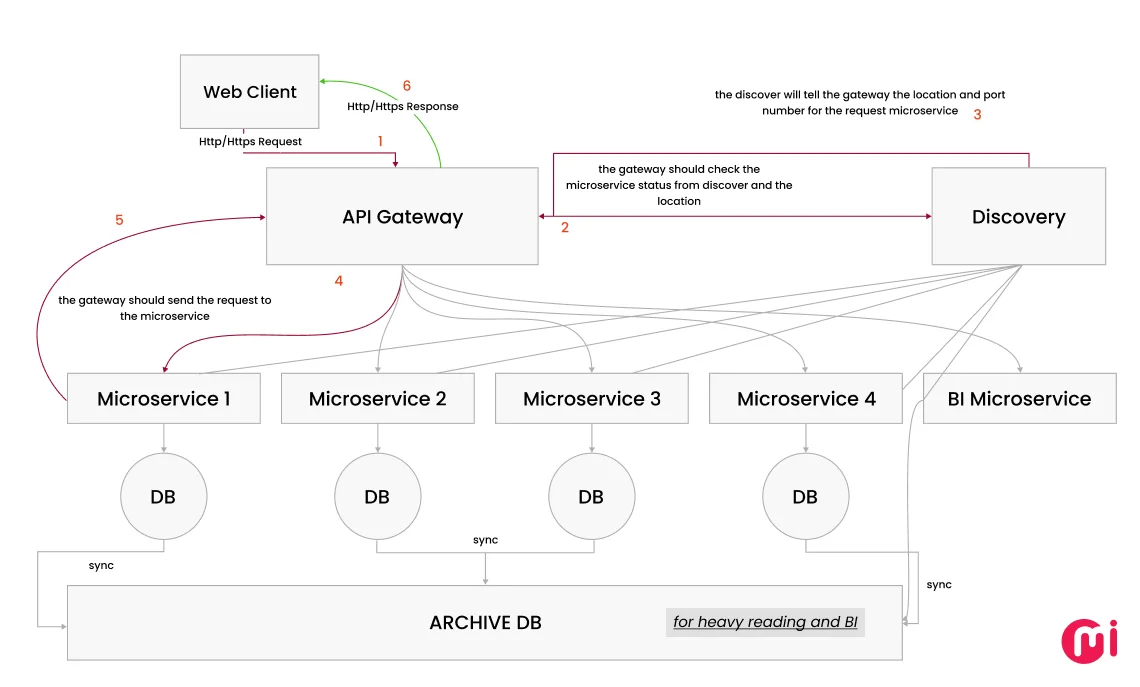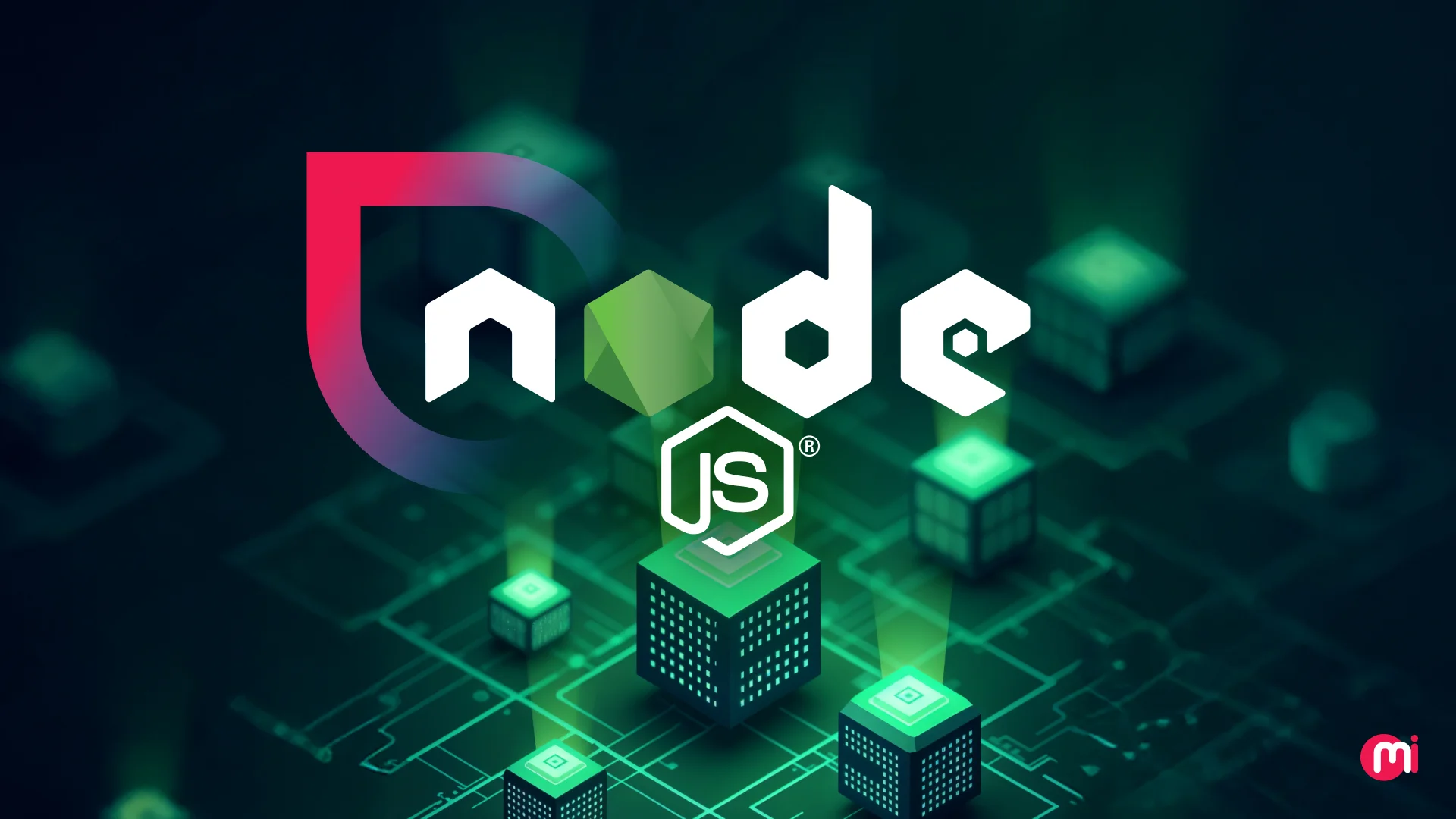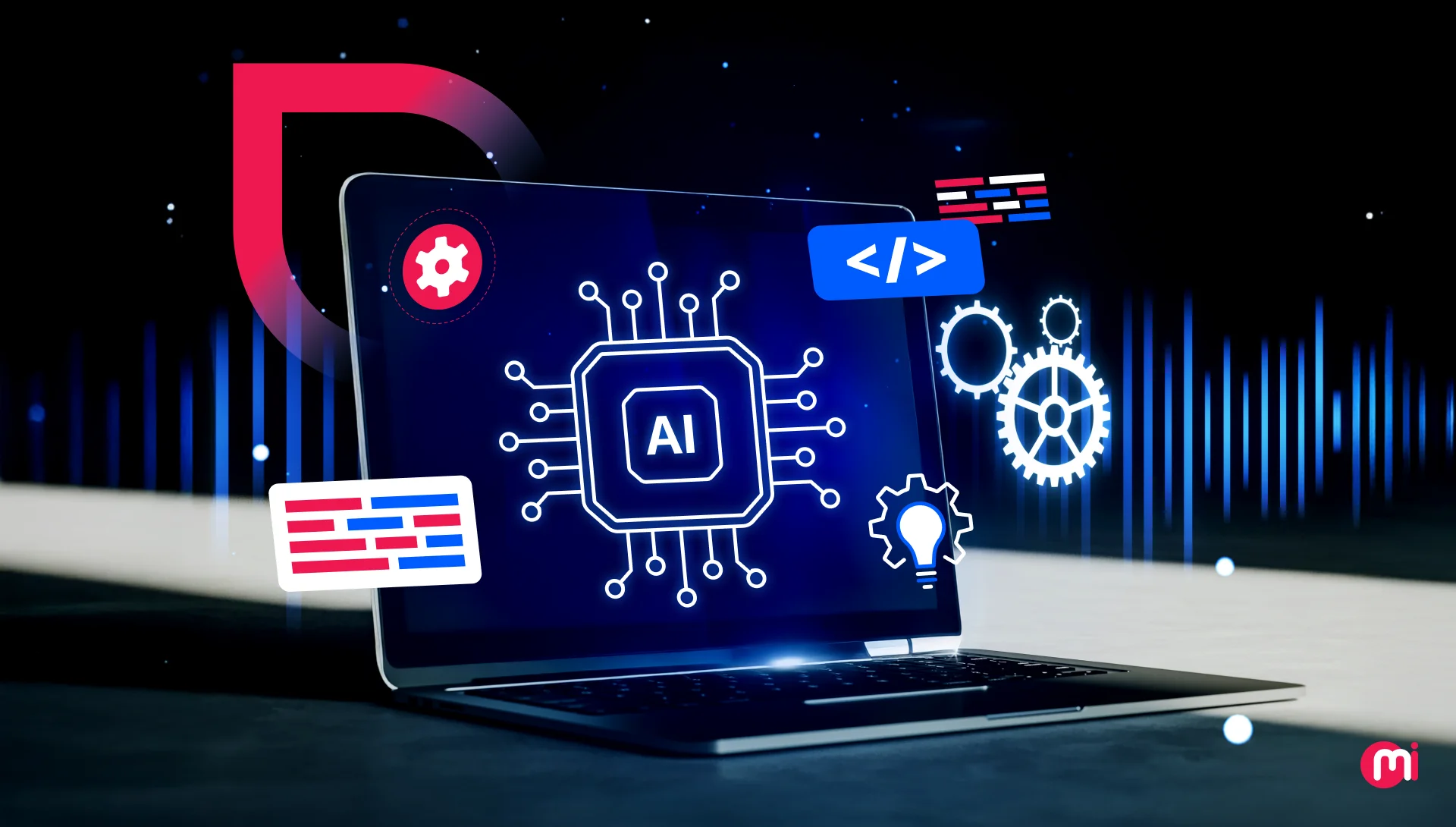The CTO’s Guide to Building Scalable Microservices with Node.js
- Web
- May 15, 2025
Curious how Netflix ensures seamless real-time streaming, even during peak releases? Or how Uber powers its high-volume, real-time ride operations with ease? The answer is Node.js microservices! In this comprehensive blog, you’ll explore top Node.js benefits for microservices development, a step-by-step process, and best practices with potential challenges and solutions.
Modern enterprises demand architecture that scales seamlessly, adapts quickly, and recovers like Wolverine. In this digital age, relying on monolithic architecture can become a bottleneck for business growth, slowing down scalability and time to market.
Hence, it’s best to implement microservices for your projects like SaaS platforms, finance applications, on-demand streaming services like Netflix, online marketplaces, aggregator platforms, or more. However, to implement this, you need the right technology stack that’s not just familiar but also blends well with your application tech stack.
That’s where Node.js aligns naturally in the microservices architecture development tech stack. While there are countless benefits of developing microservices in Node.js, they also bring certain challenges.
This blog will help you develop microservices with node.js, covering a step-by-step approach and best practices.

What Is Microservices Architecture?
Microservices architecture is a modern approach to software development solutions, where a large build is broken down into a collection of small, independent services.
In this architecture, each microservice:
- Works on its own
- Talks to other services over a network
- It can be built, changed, and fixed without touching the rest of the app.
The best things about microservices architecture are:
- Each service in this architecture is designed to do one thing well (e.g., user authentication, payment processing, or order management).
- Different services can be built using different programming languages, frameworks, or databases.
- Teams can build, test, deploy, and scale services independently without affecting the entire system.
- Services communicate over network protocols like HTTP/REST, gRPC, or message queues.
- If one service fails, it doesn’t bring the whole system down.
But don’t get confused over microservices with the API concept, as they are created to be independent and then work in an integrated manner and in harmony with the entire system. Plus, our blog on Microservices vs API will provide you more clarity around this concept.

How to Build Microservices in Node.js
Key steps in implementing microservices with Node.js include setting up the Node.js environment, designing and implementing microservices, testing, deploying, and monitoring the developed environment.
When employing node.js for microservices, don’t forget to keep this architecture under consideration:

Let’s have a look at practical steps to building microservices with node.js:
STEP 1: Set up your Node.js development environment
At the very beginning of creating microservices using Node.js, you first need to establish a Node.js environment. For that, you should first:
Install Node.js: Download and install the very latest version of Node.js from the official Node.js website.
Once Node.js has been installed, next you have to create a repository using mkdir user-service and move inside the folder using cd user-service.
Initialize the Project: Use npm init -y to create a package.json file.
Set up project structure: Create folders like src, routes, controllers, services, and config to keep things modular.
bash
mkdir user-service && cd user-service
npm init -y
npm install express dotenvSTEP 2: Build individual microservices using Express.js
Each microservice works as an independent app. So, you have to decompose your monolith, define service contracts, and work on data management.
For that, Express.js, a lightweight and flexible node.js web application framework helps to quickly develop microservices. So, let’s:
- Create separate “user services” and “order services” for different business domains.
- Define RESTful endpoints for each service.
- Keep services stateless and focused on a single responsibility.
FILE: user-service/index.js
const express = require('express');
const app = express();
const PORT = 3000;
app.get('/users', (req, res) => {
res.json([{ id: 1, name: 'Alice' }]);
});
app.listen(PORT, () => console.log(`User service running on port ${PORT}`));This service acts as a User Microservice responsible for providing user data independently.
So, what this code does:
- Sets up a basic Express server on port 3000.
- Exposes one endpoint: GET /users
When you hit http://localhost:3000/users, it returns a static JSON response:
[{ "id": 1, "name": "Alice" }]FILE: order-service/index.js
const express = require('express');
const axios = require('axios');
const app = express();
const PORT = 3001;
app.get('/orders', async (req, res) => {
const users = await axios.get('http://localhost:3000/users');
res.json({ orderId: 101, user: users.data[0] });
});
app.listen(PORT, () => console.log(`Order service running on port ${PORT}`));This service acts as an Order Microservice that aggregates data from the user service to fulfill its own functionality.
What this code does:
- Set up another Express server on port 3001.
- Imports axios to make HTTP requests.
- Defines one endpoint: GET /orders
When called, this endpoint:
- Fetches users from the user-service at http://localhost:3000/users
- Combines that with mock order data and responds:
{
"orderId": 101,
"user": { "id": 1, "name": "Alice" }
}You know, you can also develop micro-frontend architecture leveraging the concept of microservices architecture.
STEP 3: Set up communication with services using RESTFul API and message broker
Once each service is implemented to handle its specific tasks, it’s time to connect them using message queues or gRPC for inter-service communication.
For simple communication setup, you can use the HTTP REST API:
// In order-service
const axios = require('axios');
const users = await axios.get('http://localhost:3001/users');Here, each service calls another via HTTP.
The second approach you can try is through Message Broker (RabbitMQ, Kafka); it’s ideal for decoupled communication (event-driven):
- Emit events (e.g., order_created)
- Other services subscribe and react
STEP 4: Apply security best practices to your microservices
While microservices offer faster performance to applications and their functions, their concept of segmenting each service as different can become a potential entry point for attackers. There, even a single vulnerability can compromise the entire system. Hence, it’s essential to secure it while implementing microservices in Node.js.
So, to apply security in microservices using Node.js, you have to install helmet and use API keys or JWTs (JSON Web Tokens)
bash
npm install helmet jsonwebtokenAfter it’s done, it’s time to implement JWT authentication into a microservice to secure endpoints. Here’s an implementation example of it:
.Js
const helmet = require('helmet');
const jwt = require('jsonwebtoken');
// Use Helmet
app.use(helmet());
// Protect route
app.get('/protected', (req, res) => {
const token = req.headers.authorization?.split(" ")[1];
if (!token) return res.sendStatus(401);
jwt.verify(token, 'your-secret-key', (err, user) => {
if (err) return res.sendStatus(403);
res.json({ message: 'Secure Data', user });
});
});To summarize this code, this code ensures that only users with a valid JWT can access the /protected endpoint. This improves the security through:
- helmet – a middleware that helps secure your app by setting various HTTP headers (e.g., to prevent XSS and clickjacking).
- Jsonwebtoken helps verify JWTs to enable secure authentication (route-level access control).
STEP 5: Deploy Node.js microservices with containers and integrate with serverless platforms
To run and manage Node.js microservices in production, you can use two modern deployment strategies:
- Deploy with containers (Docker, Docker Compose, Kubernetes)
- Integrate with serverless architecture-based platforms (AWS Lambda, Serverless Frameworks, Vercel)
You can also combine these strategies, which many companies often use. In this combined case, you can:
- Use containers for long-running services (e.g., databases and auth servers)
- Use serverless platforms for event-driven or lightweight microservices (e.g., sending emails and resizing images)
So, for our implementation example, we’re going to use a combination of practice containers and serverless platforms for Node.js microservices.
But out of many web application architectures, have you thought about why to use serverless with microservices? Read the linked blog for the same.
Let’s first start with creating a Dockerfile:
🐳 Dockerfile
FROM node:18
WORKDIR /app
COPY package*.json ./
RUN npm install
COPY . .
CMD ["node", "src/app.js"]docker-compose.yml:
version: '3'
services:
user-service:
build: ./user-service
ports: - "3000:3000"
environment:
MONGO_URI: mongodb://mongo-user:27017/user-db
mongo-user:
image: mongo
order-service:
build: ./order-service
ports: - "3001:3001"
api-gateway:
build: ./api-gateway
ports: - "8080:8080"These containers allow you to package a microservice with everything it needs to run. It includes Node.js runtime, dependencies, and code. So, it enables microservices to work consistently across different environments.
Why use containers for developing microservices in Node.js?
- Consistent deployments from dev to production
- Easy to scale individual microservices
- Portable and lightweight
- Compatible with orchestration tools like Kubernetes
Want to know why we’ve used Docker here? Our guide on Kubernetes Vs Docker cites the clear difference.
While in real deployments they’re typically separate, here’s a hybrid example that:
- Runs as a Dockerized Node.js server (Express)
- Has one route behaving like a “microservice.”
- Another route simulating a “serverless function” (in a function-style and stateless manner)
.Js
// app.js
const express = require('express');
const helmet = require('helmet');
const app = express();
app.use(helmet());
app.use(express.json());
// --- Microservice Route ---
app.post('/register', async (req, res) => {
const { name, email } = req.body;
// Simulated database registration
console.log(`Registering user: ${name} (${email})`);
// Call "serverless" function
const response = await sendWelcomeEmail(name, email);
res.json({
message: 'User registered.',
emailStatus: response.message,
});
});
// --- "Serverless" Function Simulated ---
async function sendWelcomeEmail(name, email) {
// Imagine this is hosted on AWS Lambda — here it's local for demo
console.log(`Sending welcome email to ${name} at ${email}...`);
// Simulate delay
await new Promise(resolve => setTimeout(resolve, 500));
return { message: 'Welcome email sent (simulated).' };
}
// Start server
const PORT = process.env.PORT || 3000;
app.listen(PORT, () => console.log(`App running on port ${PORT}`))This one-file Node.js application (app.js) demonstrates how to combine a containerized microservice with a serverless-like function in a simple, unified setup:
- Built with Express.js for handling HTTP requests.
- Secured using Helmet to guard against common web vulnerabilities.
- Includes a /register endpoint simulating a user registration service (microservice logic).
- Internally calls a stateless sendWelcomeEmail function to mimic serverless behavior (like an AWS Lambda).
- Fully Docker-compatible, making it easy to containerize and deploy.
- Ideal for prototyping, learning microservices/serverless patterns, or testing integrations locally.
This setup gives developers a practical foundation for building scalable systems that later can be separated into true microservices and cloud-based serverless functions. Like, we leveraged serverless for building the Nutristar – as fitness e-commerce (aggregator) platform.
You know, we’ve used Express.js here, as it’s one of the best Node.js frameworks.
STEP 6: Implement load balancing and observability
In a microservice architecture, as your system grows, performance, reliability, and visibility become critical. That’s where load balancing and observability come in.
Load balancing helps to distribute incoming traffic across multiple instances of your Node.js microservices. This helps to avoid overloading a single server, improve application performance and responses, and enable horizontal scaling.
To implement Load Balancer in your Node.js microservices:
- You need to use a reverse proxy/load balancer like:
- Nginx
- HAProxy
- AWS ELB/Google Cloud Load Balancer/Azure Application Gateway
- Or use Kubernetes (kube-proxy, Ingress) for service-level balancing
- You can also use the PM2 cluster mode to simulate basic load balancing in development.
Here’s an example of an Nginx config snippet.
upstream node_app {
server app1.example.com;
server app2.example.com;
}
server {
listen 80;
location / {
proxy_pass http://node_app;
}
}Once load balancing is achieved, it’s time to set up logging and monitoring, which can be done through observability.
Observability gives Node.js for microservices development the ability to understand the internal state of the system from the outside. It is done through logs, metrics, and traces.
Achieving observability helps to quickly detect and fix performance issues or errors, monitor health and usage trends, and ensure accountability and compliance.
Key Pillars:
- Logging helps to track what’s happening inside services (tools: Winston, Pino, Bunyan)
- Metrics help to monitor app health and performance in response time and memory usage (tools: Prometheus, StatsD, Datadog)
- Tracing helps to follow requests as they travel through microservices (tools: Jaeger, OpenTelemetry, Zipkin)
Here’s an example of implementing logging with Winston:
npm install winston.Js
const winston = require('winston');
const logger = winston.createLogger({
transports: [
new winston.transports.Console(),
new winston.transports.File({ filename: 'app.log' })
]
});
logger.info('Microservice started.');After achieving load balancing and observability, as an output, you can:
- Ensure your services scale under traffic
- Gain insights into behavior, failures, and bottlenecks
- Maintain high availability and system health.
Challenges of Using Node.js for Microservices Development with Solutions
When using Node.js for microservices development, developers may face challenges like complexity in distributed systems, network latency, data inconsistencies, single-threaded nature, CPU-intensive tasks, and many others.
Check out the most concerning challenges you may face when developing microservices using Node.js:
1. Callback Hell & Async Complexity
Node.js is inherently asynchronous, which is its strength for I/O operations. However, when it comes to early patterns like nested callbacks, it can make code complex and hard to debug and maintain, specifically in microservices.
In microservices, asynchronous characteristics of Node.js are also applied to its services’ operations like DB queries, API calls, and message broker events. In this, deeply nested callbacks can increase technical debt and introduce hidden bugs.
Solutions:
- Adopt modern async/await syntax to flatten and simplify async logic.
- Use promise chaining and error handling patterns.
- Use frameworks like NestJS, which offer built-in support for async programming in a structured way.
2. Single-Threaded Nature & CPU-Intensive Tasks
Node.js operates on a single-threaded event loop, which again makes it excel at handling I/O operations. But this characteristic of Node.js is less in favor when dealing with CPU-intensive operations like encryption, image processing, or complex calculations.
If one service starts blocking the event loop, it can delay or freeze requests, affecting overall responsiveness, specifically under high load. This nature can become a big NO for microservices.
Solutions:
- Offload heavy tasks to worker threads using the worker_threads module.
- Delegate processing to dedicated microservices written in more CPU-efficient languages (e.g., Go, Rust, Python).
- Use message queues (e.g., RabbitMQ, Kafka) to handle async processing in the background.
3. Memory Leaks & Stability Issues
While Node.js comes as one of the best backend frameworks, it also has downsides like poor memory management, circular references, and improper stream handling.
In microservices, one leaking service can slow down or crash the entire microservices architecture. This also leads to unpredictable behavior under load, which is dangerous in production environments where uptime is critical. Moreover, memory leaks in microservices are hard to trace.
Solutions:
- Use monitoring tools like Clinic.js, Heapdump, or New Relic to detect leaks early.
- Run services with health checks and memory limits (e.g., in Kubernetes) to restart them before they crash.
- Implement structured logging to identify unusual patterns in memory usage.
4. Dependency Bloat & Security Vulnerabilities
The Node.js ecosystem thrives on packages. When developing microservices using Node.js, each of its services can have hundreds of dependencies. This leads to dependency bloat, opening doors to supply chain attacks, vulnerabilities, or versioning conflicts.
Solutions:
- Use tools like npm audit, Snyk, or Dependabot to track and patch vulnerable packages.
- Enforce a dependency policy—use only vetted libraries.
- Regularly review packages and remove unused or outdated ones.
5. Inconsistent Coding Standards Across Teams
In large organizations or distributed teams, different developers or squads may adopt varying styles, architectures, or naming conventions. If followed the same in the development of microservices using Node.js, it can lead to inconsistency and complexity.
As services scale, poor standardization leads to onboarding friction, tech debt, and inter-service communication issues.
Solutions:
- Define and enforce a Node.js coding standard using tools like ESLint, Prettier, and EditorConfig.
- Use a shared template or boilerplate repo for all microservices.
- Hire TypeScript developers to implement TypeScript for better type safety and clarity.
- Adopt monorepo or standardized folder structures (with Nx, Turborepo, or Lerna) where applicable.

Best Practices to Implement Node.js Microservices at Scale
When using Node.js for microservices development, it’s essential to follow some best practices, such as keeping the architecture loosely coupled, using an API gateway to manage and route external requests, implementing CI/CD early on, designing for failure, using circuit breakers, and more. To define best practices for this, it’s a must to know the advantages and disadvantages of Node.js.
Let’s have a look at the most popular best practices for implementing Node.js microservices:
Design for Failure and Resilience
This practice asks for assuming from the start that failures like network outages, service crashes, and slow dependencies will happen. If you follow this mindset from the start, you can create better strategies to avoid all those failures that may happen in the future. This will help you create a Node.js microservices architecture that anticipates, isolates, and recovers from these failures while keeping the entire system up.
Now, how you can implement using Node.js for microservices:
- Use timeouts and fallback logic in all service calls.
- Deploy health checks (e.g., /healthz endpoints) and readiness probes in Kubernetes.
- Isolate failure domains using bounded contexts. So, if one microservice fails, others keep running.
To sum this practice up, you should think of each service as disposable. Achieving their resilience means designing each to support graceful degradation, not just uptime.
Use Lightweight Communication (HTTP/REST, gRPC, or Message Brokers)
Communicating between microservices is essential. This means microservices should communicate in a non-blocking, low-overhead way to maintain speed and responsiveness. Hence, you should choose protocols that suit your use case.
Best options and where to use protocols in Node.js for microservices:
- REST (Express.js, Fastify) is best for web/mobile APIs and simple inter-service communication.
- gRPC (Google Remote Procedure Call) is ideal for internal services that need low latency and strong contracts.
- Message brokers like Kafka, RabbitMQ, and NATS are great for decoupled, event-driven systems and asynchronous processing.
In the end, this best practice advice is to avoid heavyweight communication, like shared DB calls or tight service coupling, and keep services loosely connected.
Implement API Gateway
An API gateway acts as a front door to your microservices. This gateway handles routing, authentication, rate limiting, and cross-cutting concerns.
Benefits of implementing an API gateway in Node.js architecture include:
- Simplified frontend/backend separation with a Backend-for-Frontend (BFF) approach.
- Unified point for logging, security policies, and version management.
- Reduction in direct exposure of internal microservices to the internet.
Here, tools like NGINX, Kong, Express Gateway, or the NestJS API Gateway pattern help.
Implementing an API gateway at the time of developing microservices in Node.js is extremely crucial when you have multiple touchpoints (web, mobile, IoT) accessing services.
Handle Failures Gracefully with Circuit Breakers and Retries
No developers like to fix problems again and again, like when one failure leading to another. This chain reaction/domino effect of failures is known as cascading failures. When that happens in the microservices environment, it can tangle up the case to the next level. Hence, to protect your Node.js microservices environment from cascading failure, monitoring and control over failed service interactions can help.
For that, you can use circuit breakers, retries, and fallbacks as your best practices. Now, let’s understand where each works well:
- Circuit breakers (just like in electrical setups) trip if a service is failing repeatedly.
- Retries attempt the call again with exponential backoff
- Fallbacks provide alternate flows or cache responses
This leads to one of the golden rules in Node.js microservices development: “It’s better to skip a feature temporarily than crash the whole system.”
Use TypeScript for Better Maintainability
The dynamic nature of Node.js makes it the best candidate for faster web app development services, but it makes it risky at scale. That’s where TypeScript development services come to the rescue.
TypeScript adds static typing, which makes your codebase more robust and self-documenting.
In microservices development with Node.js, TypeScript plays an important role as it:
- Prevents runtime errors in large, distributed codebases.
- Helps with clear contracts between services, especially when APIs evolve.
- Enhances developer productivity with autocomplete, refactoring tools, and compile-time checks.
When there’s an organized setup of a dedicated software development team, TypeScript becomes a shared language of intent.
Invest Early in CI/CD and IaC
In the development phase, efficiency with consistency and keeping security the topmost priority is a must. Plus, manual deployments become dangerous and error-prone as the services grow into microservices.
That’s why, to move fast and safely in a microservices setup, you should not overlook the benefits of DevOps. You can use it to automate pipelines (CI/CD) and leverage infrastructure-as-code (IaC) to manage the complexity of deployments.
So, to achieve those in Node.js microservices, as a best practice, you can:
- Use GitHub Actions, GitLab CI/CD, or Jenkins to automate testing, linting, and deployments.
- Define infrastructure with Terraform or Pulumi.
- Containerize each service with Docker and orchestrate with Kubernetes.
- Set up canary deployments, rollbacks, and zero-downtime updates.
Want to know why this DevOps automation is the best practice? For that, you have to read our blog on DevOps vs Agile for better understanding.
Why Choose Node.js for Microservices Architecture
Node.js is the most preferred choice for building microservices architecture. Its lightweight, event-driven nature, paired with a powerful JavaScript ecosystem, makes it an ideal foundation for fast, scalable, and cloud-native/cloud app development.
These characteristics also make Node.js the best fit for enterprise app development projects.
Here’s why to use Node.js for microservices development:
- It offers quicker feedback loops, faster MVP launches, and accelerated innovation in microservices because it uses a non-blocking I/O model and follows asynchronous coding.
- Node.js is inherently lightweight, making it ideal for containerized environments, serverless architectures, and edge deployments.
- Microservices built with Node.js inherit its supportability for modular architecture, allowing them to be independently deployed and scaled based on specific workloads.
- Node.js is ideal for developing real-time applications (like the chat application, ones supporting real-time notifications, live updates, and IoT solutions) as it supports asynchronous I/O capabilities and WebSockets.
- Node.js is ideal for cross-functional teams as it supports parallel development, allowing developers to work on different microservices simultaneously without stepping on each other’s toes.
If you see Node.js development trends, you will find Microservices are one of those.
Conclusion
Indeed, microservices offer a scalable and flexible way to build modern applications. When it comes to embracing this architecture, choosing the right technology stack plays a key role in the success. There, Node.js comes as the best option for microservices with its support for fast, collaborative development and operational efficiency.
However, the decision boils down to your application’s needs and the team’s goals. If you’re building real-time services, need quick iterations, or want to embrace a cloud-native mindset, Node.js is worth serious consideration.
As you plan your architecture, don’t just think about how to build your microservices using Node.js but also how this tech will help you evolve, scale, and keep microservices running smoothly in production.
How MindInventory Can Help You Build Microservices with Node.js
When there’s a thing about thinking not just about solving present challenges but also about getting ready for what the future can bring, MindInventory comes as your ideal Node.js development company. We specialize in designing and developing microservices architectures with Node.js that are robust, scalable, and cloud-ready.
Whether you’re building a new software product solution from scratch or modernizing an existing monolith, our team brings deep expertise in Node.js development, API design, containerization, and DevOps practices.
We help you:
- Hire node.js developers with experience in microservices know-how
- Use proven software development methodologies for faster time-to-market and agile delivery
- Deploy microservices using Docker, Kubernetes, and serverless platforms
- Get full-cycle support from planning and architecture to deployment and scaling
- Optimize security, performance tuning, and real-time systems.

FAQs About Developing Microservices Using Node.js
Yes, Node.js is highly suitable for microservices development and is CTOs’ favorite option. Why? Because non-blocking, event-driven architecture, lightweight runtime, and an extensive npm ecosystem make it ideal for building scalable, independently deployable services with fast I/O performance.
You should consider using Node.js when building real-time applications, APIs, or microservices that require high concurrency, fast performance, and quick development cycles. Using Node.js is highly beneficial for developing MVPs and cloud-native applications.
Node.js is not recommended for use when implementing CPU-intensive tasks like heavy computation, complex data processing, and machine learning workloads.
If these functions are implemented with Node.js, there are chances to block the event loop and degrade performance. Hence, in such cases you should use programming languages like Python or Go.
You should go for microservices architecture if you’re developing an application that needs to scale different parts independently, support multiple development teams, improve fault isolation, or handle complex, evolving business logic.
Node.js in microservices is used to build lightweight, independent services that communicate via APIs or messaging queues. Node.js is asynchronous in nature and supports REST, GraphQL, and WebSockets, which make it ideal for efficient inter-service communication and real-time data handling.
Best use cases for Node.js microservices include SaaS platforms, fintech applications (wallets, real-time risk engines), on-demand streaming services, online marketplaces and aggregator platforms, and some lightweight ML APIs or edge AI use cases.
Avoid microservices if your application is small, has limited scope, or lacks the resources to manage distributed systems.
Yes, Node.js is generally better than Python for real-time microservices. Why? Because Node.js can handle multiple simultaneous connections efficiently thanks to its event-driven, non-blocking architecture.
Hence, Node.js is ideal for developing chat apps, live notifications, and collaborative tools, where real-time interactions are essential.
Yes, Node.js is highly suitable for lightweight containerized and serverless microservices. Its fast startup time, minimal resource usage, and compatibility with cloud platforms like AWS Lambda and Docker make it an excellent fit for modern deployment environments.
Netflix, LinkedIn, PayPal, Walmart, Uber, and eBay are the top companies leveraging Node.js microservices for better platform scalability and performance benefits.













